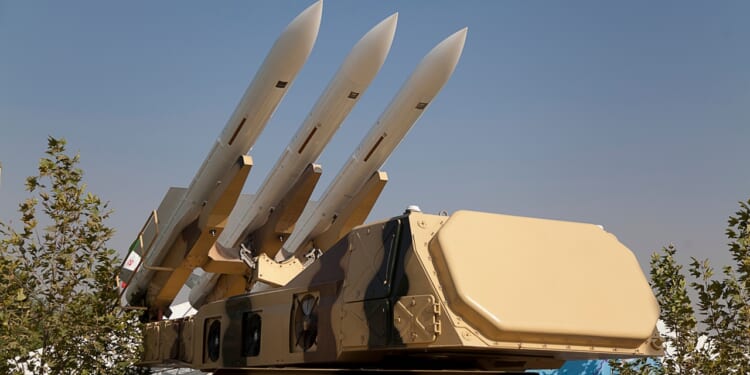The fact of the matter is that the Khordad-15 system is woefully unproven—and the U.S. and Israeli air forces are among the best in the world.
Iran’s Khordad-15 is a domestically produced surface-to-air (SAM) system designed to bolster the Islamic Republic’s defense capabilities. Recent video posted to social media suggests that the Iranians are moving large numbers of these systems to key strategic positions around the country, as both the United States and Israel continue threatening suspected Iranian nuclear weapons development facilities with significant air strikes.
Named after the 15th day of the Iranian calendar month, Khordad, commemorating a significant event in the 1979 Islamic Revolution, the system represents a milestone in Iran’s pursuit of military self-reliance.
The Story of the Khordad-15
Developed by the Iran Aviation Industries Organization (IAIO) under the Ministry of Defense, Khordad-15 is a medium-to-long-range air defense platform intended to counter a variety of threats, ranging from fighter jets, stealth aircraft, unmanned aerial vehicles (UAVs), and cruise missiles. Using a passive electronically scanned array (PESA) radar, it is believed to be able to detect and track aerial targets with a degree of sophistication uncommon in other domestically produced Iranian systems. The system is believed to be able to detect jets and drones at a range of up to 93 miles away, it can track objects within 74 miles and engage targets at around 46 miles out from the system with its Sayyad-3 missiles.
For stealth targets, Khordad-15 can reportedly detect targets at 52 miles and can engage those stealth targets at 28 miles. The system’s maximum operational altitude is around 15 miles, or roughly 80,000 feet—meaning it can intercept high-altitude targets as well.
Each launcher is mounted on a military truck and carries four missile canisters arranged in two rows, though it typically operates with one row of two canisters at a time. A separate truck houses the rotating radar antenna, enhancing mobility and flexibility—must-have features when facing the aerial strength of the U.S. and Israeli militaries.
The primary armament of the Khordad-15 air defense system is the Sayyad-3 missile, which itself is a domestically produced missile that has a reported range between 74 and 124 miles, depending on the variant.
Derived from earlier Iranian missile designs—and possibly influenced by foreign systems, like the American SM-1 naval missile—the Sayyad-3 employs inertial navigation systems (INS) for mid-course guidance and active radar homing for terminal targeting. This system is meant to engage up to six targets at once, firing up to four missiles at a time, which suggests a robust multi-target engagement capability. Iranian officials claim that the Khordad-15 can be ready for operations within five minutes of deployment.
Khordad-15’s mobility and multi-target capability make it a critical component of Iran’s layered air defense strategy, which combines short-range systems, like the 9-Dey, medium-range systems like the Raad, and long-range platforms like the Bavar-373.
By deploying the Khordad-15 around sensitive sites, such as the Natanz nuclear facility—a certain target of any future aerial strike against Iran—Tehran is signaling to both the United States and Israel that it will do its utmost to protect key Iranian infrastructure and impose costs on any attacker.
Why the Khordad-15 System Likely Won’t Work Against America
But, while Iran is clearly not interested in backing away from its commitment to developing nuclear weapons—even as Israel amasses its F-35I Adir warplane fleet and the U.S. builds up its air wing of B-2 Spirit long-range stealth bombers at Diego Garcia—the Khordad-15 system is untested. And last October, the Israeli Air Force (IAF) already demonstrated their capacity to deploy deep inside Iranian airspace and knock out essential air defense systems around suspected nuclear weapons development facilities.
There are reasons to suspect that the Khordad-15, too, will be unable to intercept aerial attackers. For one thing, many of its components are seriously antiquated. The PESA radar that Iran installed on these systems is nowhere near as advanced as the active electronically scanned array (AESA) technology that exists on many other air defense platforms—meaning that the systems will struggle to operate properly when subjected to electronic jamming or saturated attacks of the kind that any comprehensive U.S. air strike would ultimately utilize against Iranian air defenses.
The fact of the matter is that this system is woefully unproven. But the current spate of deployments it is experiencing should indicate how opposed Tehran is to any sort of denuclearization. And, when this Iranian-made system is combined with more potent Russian-built systems, like the S-300 (or possibly the S-400), it is possible that Israeli and American warplanes would have an added complication to contend with in the form of the Khordad-15 air defense system.
Then again, it might just be all for show. There is only one way to find out.
All in all, Iran certainly has moves it could make in response to an Israeli and American air strike on Iran. But the country has very little it can do in terms of actually preventing the air strike itself. The Khordad-15 demonstrates those limits.
About the Author: Brandon J. Weichert
Brandon J. Weichert, a Senior National Security Editor at The National Interest as well as a contributor at Popular Mechanics, who consults regularly with various government institutions and private organizations on geopolitical issues. Weichert’s writings have appeared in multiple publications, including the Washington Times, National Review, The American Spectator, MSN, the Asia Times, and countless others. His books include Winning Space: How America Remains a Superpower, Biohacked: China’s Race to Control Life, and The Shadow War: Iran’s Quest for Supremacy. His newest book, A Disaster of Our Own Making: How the West Lost Ukraine is available for purchase wherever books are sold. He can be followed via Twitter @WeTheBrandon.
Image: Shutterstock / saeediex.
















